How to plaster old damp walls - do not use any type of Gypsum based plaster, like Bonding, Browning or Carlite - only apply sand and cement backing coats, incorporating Renderproof and then you can 'skim finish' using a multifinish type skim plaster.
Order and Free Technical Help - 01626 872886 - our experts answer your call - discuss your building problem with a Qualified Dampness Expert (C.R.D.S.)
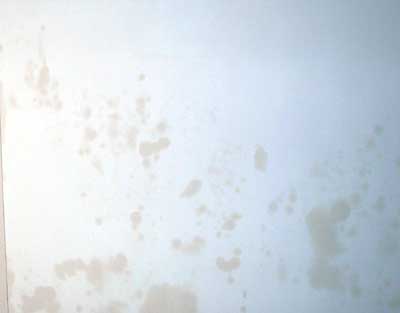
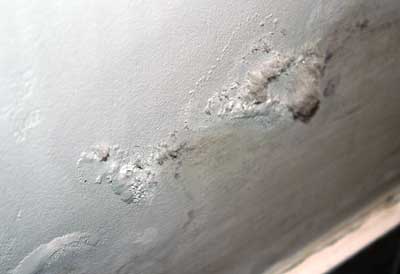
Damp patches coming through new plaster - the wrong plaster! Salts pushing paint off a recently redecorated wall - the wrong plaster!
Click here to see the Products, prices or to Order
Click here for Renderproof Data Sheet
Replastering old walls - indoors specification, the Professional Standard in the UK using Renderproof.
1. Hack off all old plaster to at least 300mm clear of all signs of damp or salt and at least 1 metre above ground floor level - use a meter to test the walls and remove plaster at least 300mm above the highest level that readings can be obtained.
Reason - This is to ensure that the residual 'salts' do not climb above the new plaster in the future.
2. Brush the walls to remove all plaster residue, particularly around angle beads.
Reason - old plaster will have 'salt' in it and will cause damp spots to appear in time.
3. Wet the walls and apply two coats of Salt Neutraliser, wetting again with fresh water between coats
Reason - old plaster will have 'salt' in it and the Salt Neutraliser will reduce the risk of these 'salts' resurfacing and spoiling the decorations in the future
4. Repair any holes or poor joints with sand and cement (4:1) using washed, sharp (means slightly gritty) plastering sand (sometimes called screeding or rendering sand). Do not use fine, unwashed sands.
Reason - fine, unwashed sands often contain salt and the fine particles are too numerous to find enough cement particles to bond together tightly - these two problems make for a weak render, prone to the easy passage of 'salts'.
5. Special Note - walls made with non-porous stone or brick, like granite or blue brick, will require an adhesive to help stick the render coat to the wall - use BondAcryl concentrate)
Reason - normal renders and plasters stick to the wall by suction - the surfaces need to absorb some water. Without this suction the render or plaster will not grab the wall and may become loose and hollow as it dries.
6. Damp the walls lightly (to reduce 'suction', which can cause excessive drying and cracking) and apply a thin coat (maximum 1/2 inch, 12.5mm) of render consisting of 3 parts sand - dry, washed, sharp (means slightly gritty) plastering sand (sometimes called screeding or rendering sand) with 1 part of fresh (free flowing - no lumps) Portland Cement.
Reason - thick coats are more likely to slump down the wall during application and crack during drying out.
7. Scratch the render surface liberally all over with a nail board, trowel, metal float or similar object.
Reason - without these scratches the natural drying shrinkage will cause cracking, crazing and hollowness to develop - the next coat will probably pull the first coat off as it dries.
8. Use only Renderproof water proofer/plasticiser in the water that the render is mixed with, at the rate of 1 part Renderproof to 40 parts of water. Do not use fine, unwashed or wet sands.
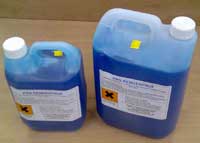
Blue Renderproof concentrate - dilute 40:1 with water
Click here to see the Products, prices or to Order
Reasons - Renderproof binds the sand to the cement and prevents liquid water passing through. It also makes the mix stickier (plasticising) which help to hold the render together. Wet sand weighs more than dry, so it will make your mix weak. Fine sands produce a weak, powdery render, which will not resist 'salts'. Do not allow the plasterer to add plaster (usually 'browning') or washing up liquid to the mix.
9. When the render surface is firm enough (but not bone dry, or it will need re-wetting) apply a second coat to exactly the same specification - if further coats will be needed to reach the desired thickness don't forget to scratch liberally. In hot weather spray the render surface with water to slow the drying process.
Reasons - excessive drying out increases the suction and can prevent one coat sticking to another. Rapid drying always increases shrinkage, which gives rise to cracking of the render or finish plaster.
10. Whilst still damp (or re-wet again) apply a skim coat of Multi Finish or Board Finish. Do not polish or add water.
Reason - this will produce a shiny, glazed finish which looks good, but is prone to condensation, black mould growth and poor drying.
11.. Delay any decoration for at least one month and then only apply a thin coat of breathable emulsion paint (not a heavy vinyl) - like our Microporous Replastering Paint. Do not repaint or wallpaper for at least three months. Use a Dehumidifier if possible, to remove moisture from the walls, especially in the Winter months.
Reason - the paint or paper will fall off the wall due to the water vapour that will be trapped underneath in the new render.
Replastering Notes:
Don't forget that replastering is essential if dampness has affected your plaster because of the 'salts' that come with the water: you have two options - either replaster to our specification using sand and cement, with Renderprooff salt inhibitor/waterproofer in the water or look at the Wall Membrane option. Wall Membranes offer a considerable improvement over sand and cement - they produce a warmer surface, can be insulated easily and can be directly plastered with lightweight, modern plasters, like Carlite Bonding.
For easy fix Membrane information go to: www.drywallandfloor.co.uk
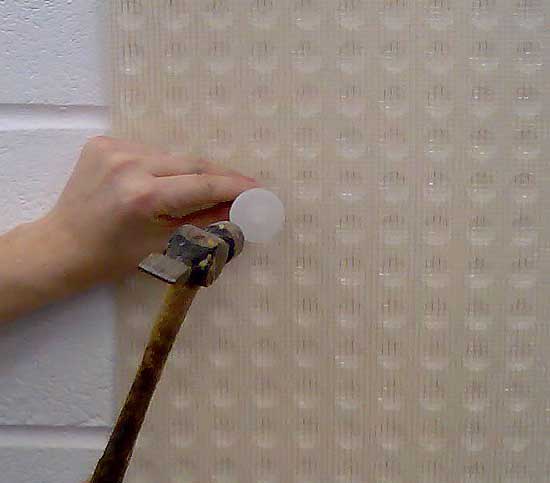
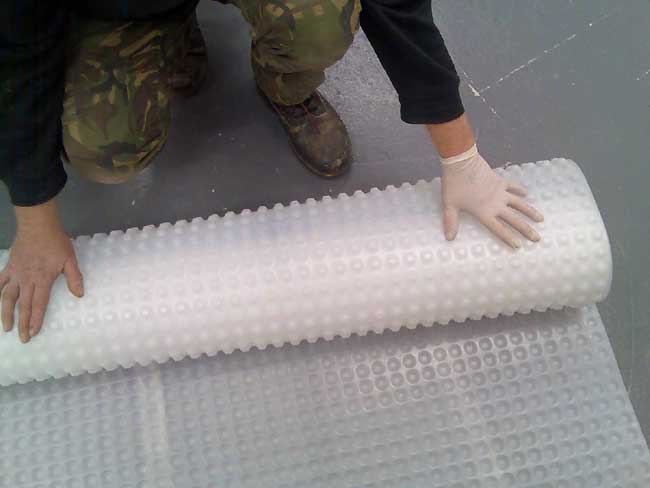
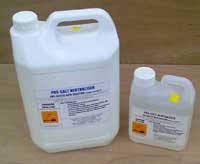
Membranes for dry walls and floors - air gap insulates. Salt Neutraliser for salty walls.
Click here to see the Products, prices or to Order
Product Data Sheets
Home | Damp | Membrane | Damp Meters | Anti-Mould Additives
| Privacy Policy | Returns Policy | Contact
Use any of our Shopping Pages to place goods in your Shopping Basket - they all use the same Shopping Cart system.

Click to view your Shopping Basket
or continue shopping by clicking on one of our Shops below.
OUR SHOPPING PAGES
- DAMP SHOP - this Site, for Damp problem solving in buildings
- REPLASTERING SHOP - how to replaster correctly using our products
- TANKING SHOP - this Site, for Damp problems below ground level
- MOLD SHOP - this Site, for Mold problems and their solutions
- SURVEYING TOOLS SHOP - this Site, for tools for surveying your building for damp
- DAMP PROOFING EQUIPMENT SHOP - pumps, injection rods, spray lances
- BORON TREATMENTS SHOP
- WOODWORM PRODUCTS SHOP
- DRY ROT SHOP
- BORACOL SHOP
- JOIST REPAIR KITS SHOP
- TIMBER REPAIR SHOP
- RESINS SHOP
- MEMBRANE FOR DAMP WALLS & FLOORS SHOP
- FIRE PAINTS SHOP
- RUST CONTROL SHOP
Property Repair Systems
T: 01626 872886
E: Mail us help@propertyrepairsystems.co.uk
Site written by: David Moore
David Moore, B.A. (Hons.), C.T.I.S., C.R.D.S. Technical Author
Google+
Other Property Repair Systems Sites:
www.boron.org.uk - how to use Boron based insecticides/fungicides to treat timber rots and insect attack
www.deck-treatment.co.uk - how to treat patio decks and yacht decks
www.dryrot.biz - how to kill Dry Rot in buildings
www.drywallandfloor.co.uk - membranes for lining damp walls, floors, basements and cellars
www.epoxy-info.co.uk - resins for repairing and sealing all types of masonry
www.fire-door-paint.co.uk - upgrade doors to 30 minutes fire resistance
www.joist-repair.co.uk - how to quickly repair joists and beams of any size
www.propertyrepairsystems.co.uk - our Home Site
www.steel-fire-paint.co.uk - treat steel with Intumescent Paint to provide fire protection
www.timber.org.uk - systems of repair, with step by step methods
www.timber-repair.co.uk - how to repair timber beams
www.woodworm-info.co.uk - how to kill and prevent woodworm and death watch beetle
www.woodworm-expert-advice-forum.org.uk - all your questions and our answers about woodworm treatment DIY
